| Works of Annie Fields |
by
Annie Fields
1896
Part 2 -- January 12 - 23
The Bahamas
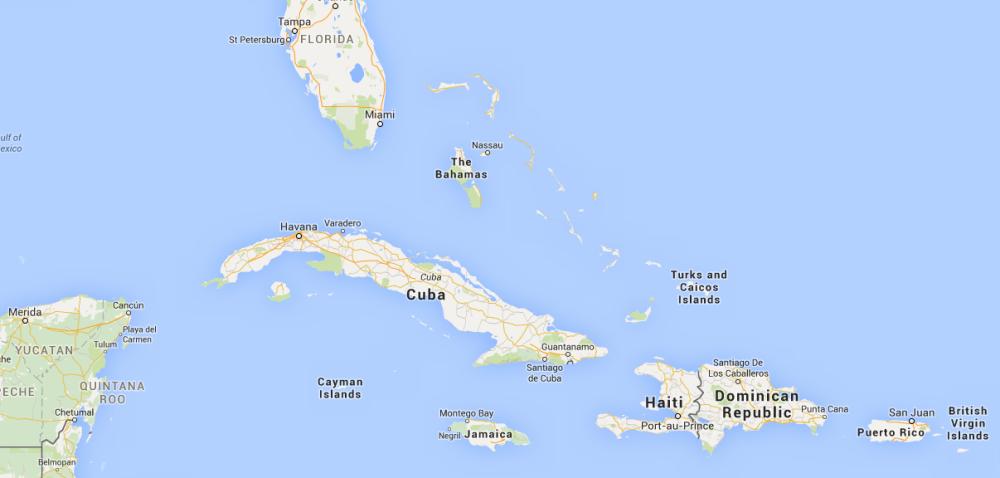
Showing the area of the Hermione's cruise.
[ Sunday January 12 - Thursday January 16
]
All day Sunday the 12th were were pretty
miserable but on the 13th the scene quite changed and we went
ashore. Nothing could be more purely tropical than the scene
^view^ as we looked about us. The water of the clearest,
light green and blue of intense color -- the cocoa palms with
their feathery tops waving or floating still, in the calm air*
-- The colored brown boys pressing about the ship in
every hue of color as to skin and every form of meagre wear as
to drapery -- [The next clause appears to be crossed out with
a light line through the text.] it is an old tale never
told yet always fresh to the eye of the seer because beauty is
always new. [End of apparent deletion]
We went ashore with the captain in an electric
launch* which must have excited some wonder in the minds of the
white-toothed crowd awaiting us, but observation of this
kind is not common to this ^ easy^ sensuous class and they
were much more interested in watching their chances to make pennies
^money^ by diving or standing on their heads, or other fertile
devices known to them than in studying our craft. The day
was softly warm with a pleasant breeze -- the soft stone of the
embankment, apparently of volcanic origin swarmed with strange
black beetles, but happily they did not trouble themselves about
us, and we soon found
Page 30
ourselves walking with out ^with
open^ [previous deletion and insertion in pencil]*
umbrellas under trees and among shrubs and flowers which threw
us into an ecstasy of enjoyment -- The scarlet Hibiscus is in
full bloom with its flame like beauty and dark under leaves -- a
silk cotton tree of gigantic size especially attracted our
wonder.* It grows behind the ^an^ old bank
and is the own cousin of the elephant -- its prototype in plant
life -- if one may say so. Its huge bulk and the strange
grey wrinkled surface of the bark gives one a sense that the
^each^ arms are ^is a^ proboscis and will soon be
approaching to ask a biscuit or ^for^ some recognition.
The tree has a magnificent pedestal as if a giant foundation
[were corrected] needed for such a world of green
loveliness and bird-land as {it} stretches out above. I presume
we had none of us ever seen so huge a tree yet lovely in
its upper world of greenery in spite of a sense of monstrosity
in its lower growth -- In the "patio" or "compound" of the hotel
was gathered a small group of the Southern ^Nassau^
people -- A young girl in a white muslin dress with two or three
gentlemen of varying hues of complexion especially attracted
me. The soft olive tint of her skin and the real charm she
possessed of manner as well as of face compelled me to turn an
instant in her direction whenever the least chance offered
itself. She made the whole place instinct with native
comeliness of expression to which we were only led up by the
soft air, the hibiscus blossoms, the almond trees and the
delicate stains of color on the walls and the gates and towers
where they
Page 31
were seen peeping out between or above the
foliage. We dined at the hotel where a new flower the
natives called it the Shell flower* charmed us upon* the
table. We drove in the afternoon along the shore of the
island, past the constabulary and some of the business houses --
also past certain walled gardens with small houses in them
looking on the sea which I thought would be tempting enough for
a winter's sojourn. There would be however very little in
the way of society. The English Governor* lives here and
his office stands high it seems by the salary which is two
thousand pounds a year and one would be obliged "to lay waste
and destroy" if one were obliged to spend more than a
fourth of that amount in Nassau one would say! The house
and grounds are given also.
But for one who loves and thus breathes in the
South like our poet,* here is charm, here is a constantly
renewed grace in existence. Every growing thing moves to
^a^ new delight. We saw our first oleander bush* at
Brunswick just as we were starting out in the afternoon for a
walk together. Do you know, he said, that leaf, as he
stood looking at it, "moves me to worship and to love, more than
all the sermons of all the men I have ever heard or shall
hear"! And now at every turn we feel ourselves spectators
at the loveliness around us. As we drove with the sea all
green and blue on one side and the cocoa-palms or sisel farms*
on the other interspersed with gardens of roses and pointsettias
[written up the right margin in pencil: Something gone here oppresses]
Page 32
the power of seeing could not keep pace with the wonders continually attracting us.
Oh! the roses! after all, they were our chief joy [two deleted words], and we came back to the ship laden with them.
The next day we still lingered in Nassau. It was not only an undiscovered land still to us, but the Hermione needed caulking which would take time. Therefore we were to be allowed to stop --
Again to shore, where again we saw our pretty
maiden sitting in the afternoon behind a kind of trellis of
cocoa-palm branches which were fastened up at one corner of the
piazza to make a kind of defense against wind sun and
observation. There was a little table there and coffee
after dinner, and a mandolin and a Celtic singer -- while we
strolled about not too near, fascinated by the pretty scene --
the tinkling of the strings and above all by the pretty
girl. Later she bade farewell to a gentleman in the hall
below. The manner was incomparable. I am sure Juliet
did no better for her Romeo in public!* In the afternoon
we took a longer drive to some strange caves fronting the
sea. The place was very weird and gave one an idea of the
coral bottom on which the island rests. It is said the the
[intended that the?] interior which is
still untamed is full of pits apparently bottomless, at least
with the sea at the bottom, covered with brush at the top, in
which many a hunter supposed to have been killed by wild
creatures, man or beast, have probably fallen and disappeared.*
Page 33
Surely there are few places less frequented it would seem at present by any harmful creature. There seems to be neither snakes nor men to attack without provocation.
If one wished to do any special work for which
solitude were required and a kind climate, I know of no place
better suited than this for undisturbed out of door life.
Notes
purely tropical ... cocoa palms:
Colors of the Nassau area are captured in a satellite photo
courtesy of Wikipedia.
Cocoa
palms
presumably are what we now call coconut palms.
Wikipedia
says: Hibiscus ...
is a genus of flowering plants in the mallow family, Malvaceae.
It is quite large, containing several hundred species that are
native to warm-temperate, subtropical and tropical regions
throughout the world. Member species are often noted for their
showy flowers and are commonly known simply as hibiscus, or less
widely known as rose mallow."
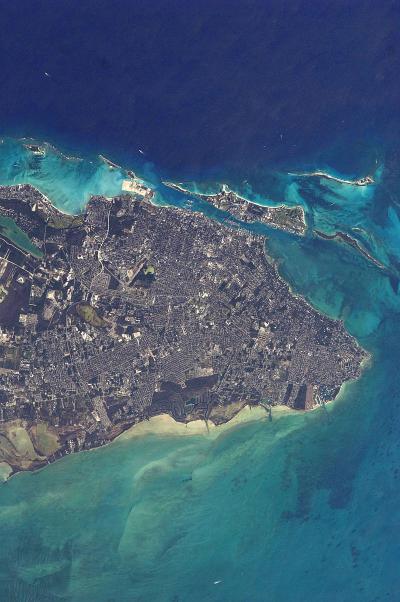 |
Plants of the Bahamas  Coconut Palm  Hibiscus |
an electric launch: See the
photograph of the Hermione in Part 1 (January 7) .
in pencil: In the parts of the manuscript
dealing with the Bahamas, there are several deletions and
insertions made in pencil. As the notes for Part 10 suggest,
these seem to indicate that Fields later worked over this part
of the original diary to produce the manuscript in Part 10,
which she may have intended to publish.
Each page of the diary is numbered in pencil
in the upper right corner. Though these numbers may have
been added by Fields, it also is possible they were added by a
curator when the notebook was unbound in preparation for
microfilming.
Silk-cotton tree: The Ceiba petrandra or Kapok in the American tropics is often called the silk cotton tree. One example of a silk-cotton tree in Nassau was typically shown in post-card photos of the period.
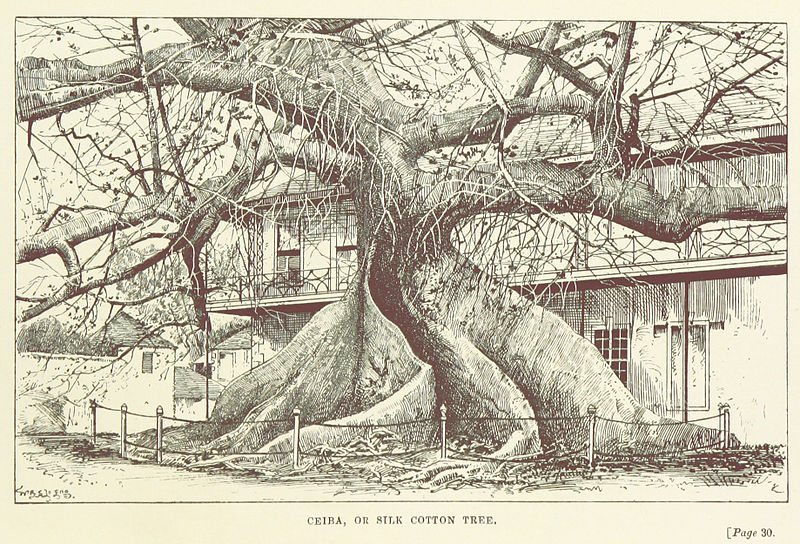
Silk-cotton tree
From Wikimedia Commons
dined at the hotel: In a letter of 16 January, to S. W. Whitman, Jewett writes that Pierce's party spent time at the Royal Victoria Hotel, that being the tourist hotel in Nassau and, therefore, likely to have the features Fields describes.
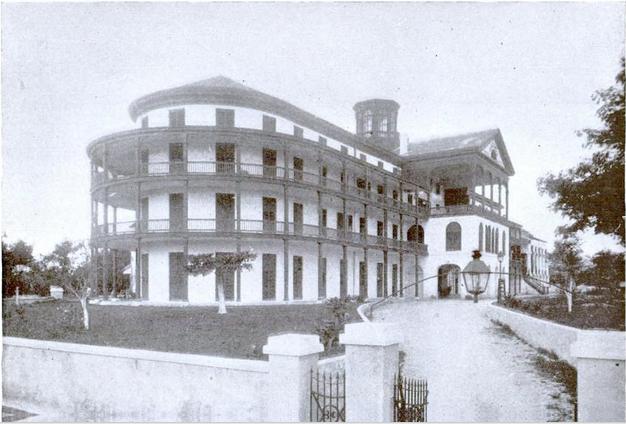
Royal Victoria Hotel, Nassau, Bahamas
Photo from Stark's
History
and
Guide to the Bahama Islands (1891), p. 7
By James Henry Stark
Shell flower: One form of local art in the
Bahamas is carving conch shells into flowers. But
there is also a tropical flower sometimes known as
shell-flower: Alpinia
zerumbet. Though not native to the Americas,
these flowers have been widely cultivated. It appears
Fields refers to an actual flower rather than a carving, but
this is difficult to confirm.
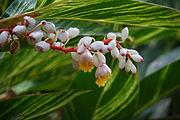
Shell-flower courtesy of Wikipedia.
upon: An X appears in the margin here.
It is possible this indicates a passage Fields intended to
use in her later draft that appears in Part 10.
The English Governor: Sir
William
Frederick
Haynes Smith was governor of the Bahamas
1895-1898.
our poet: Thomas
Bailey Aldrich.
to lay waste and destroy: See Hosea 2:12.
oleander in Brunswick: Nerium, commonly named oleander, is a widely cultivated evergreen, flowering shrub.
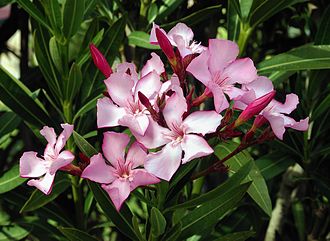
Oleander
Image from Wikepedia
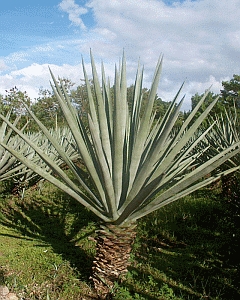
Sisal
Image from Wikipedia
Juliet ... Romeo: Protagonists of William
Shakespeare's tragedy, Romeo
and Juliet.
the coral bottom on which the island rests ... full
of pits ... snakes: The Bahama
Islands are the exposed surfaces of the Bahama
Banks, miles thick deposits of limestone. Among
the special features of the islands is the variety of caves
and holes that result from the history of this
geological formation. The Grand
Bahama underwater cave system, which sometimes opens
into inland holes or pits, is described as one of the
largest and most dangerous in the world. The
illustration below shows how these were formed. Stark
describes pits like those Fields mentions in History and
Guide to the Bahama Islands, pp. 119-20.
There are no poisonous snakes in
the Bahamas, though there are at least two species of boas.
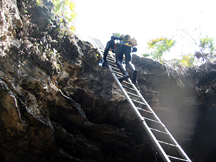 Entrance to Owl's Hole Grand Bahama From the bahamasweekly.com |
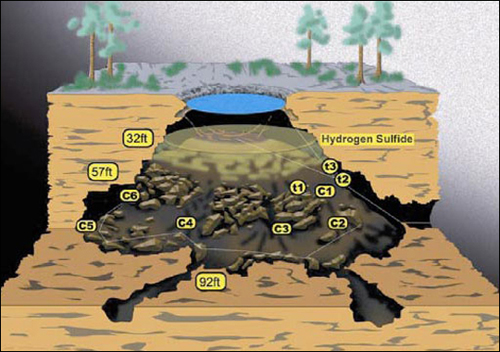 Formation of sink holes on Grand Bahama From bahamasweekly.com |
[ Friday January 17 ]
Friday, Jan. 17th We were rowed ashore under a clouded sky. A rare thing except during the rainy season, but the contrast to the brilliant sunshine gave a softness to the landscape which was very restful. how grey it grew towards afternoon and thunderous! We sat upon a broad piazza high above the ground floor ^in the hotel^ and watched the beautiful sky; at length the rain fell but softly and with none of the tempestuous signs which belong to these islands. We passed all the day on shore and when the evening came drove in the dark and rain to the phosphoric lake,* where small negroes threw themselves in the water and splashed about making moonlight for our pleasure. It is a weird scene; in this world of miracles this is one of the beautiful and strange scenes. We drove out over the fine road of limestone, with living tree walls overhung with verdure on either hand, except where an opened gate or broken wall or ^ [ pretty ?]^ unimproved land gave
Page 34
glimpses into the modest but cheerful houses of the colored
people. There was a gayly lighted school house where
some festivities were going on and two or three churches
where the voices of the singers came back into the free air,
but with these exceptions we drove on through the half
lighted way until in perfect darkness we reached the
strangely lighted lake.
How bright and gay the Hermione always seems when we return to it with its lights and flowers and men in uniform swaying about in the clear water, the stars and the new moon above -- stars and new moon below.
[A horizontal line divides this entry from the next]
Note
phosphoric lake: Stark in History
and
Guide to the Bahama Islands, p. 124, describes Lake
Waterloo or "the Lake of Fire," a phosphorescent lake near
Nassau. While this was a popular tourist destination
in the 19th century, recent tourist guides do not mention
the phosphorescent qualities that drew visitors then.
Saturday 18th Hermione was towed to the wharf for coal and water. The day was supremely beautiful after the rain of yesterday afternoon. We passed the morning on the upper deck watching the peacock hues of the water, with vessels & boats coming and going in the fresh breeze. Aldrich asked for the Victorian Anthology and showed me a really exquisite poem by that poor fool Oscar Wilde.* After which I sat and read the lovely poem with which that volume opens by Landor, "The Hamadryad" ^also^ "The death of Artemidora" and others.* How such indestructible creations of the human mind ally themselves to such loveliness of nature! One can never be remembered without the other. The talk of our poet is always
Page 35
amusing and oftentimes most instructive. He knows his own domain well and defers to the opinion of no one else. It is good to hear him say a poem is good and why it is good. He is one who knows.
Again after luncheon we rowed away through the bright water
to the town, and taking a carriage there ^we^ drove
along the bay-side and went into little shell shops by the
edge of the sea and looked over the shells and other marine
wonders. the air was bright and sweet and cool, and
it was a joy to loiter about gathering roses and driving in
the falling of the day. We came home laden with
flowers and shells and fruits.
What a different world we whisper to ourselves from the one we have left. Here we must turn our spirits like the sunflower to the sun, towards the influences of the beauty which surrounds us -- there, we turn all the forces of our being into action and despite cold and fatigue -- and disinclination hold our way like ships drawing after them the disabled or reluctant craft.
The calm sweetness of the afternoon will not be forgotten. The little shell shop opening on one side to the sea, with sun-burned fishermen or "spongers"* looking in at the windows or lounging on the seats, -- color everywhere and stillness -- even the colored children who always collect like flies wherever you go, quietly looked on and
Page 36
said nothing. The wife of the shop-keeper (they were
young people) [parenthesis marks in pencil] was
learning to play the piano, slowly & painfully in the
house opposite (by her false notes I was discouraged for her
career) [parenthesis marks in pencil] while I asked
prices and bought for the company. I loitered there
just drinking in the air and light. I tried to buy a
huge star-fish which hung like a [canope ? meaning
canopy?] in the centre of the shop with queer little
dried fishes, sponges etc. hanging from it. The
shop-keeper would not. Why not -- she asked several
times, as she as she looked about her -- at length with
tears in his eyes he told her that "one who is dead, my
brother, made that." However he offered to make us a
duplicate which he did while we drove along the shore
through a kind of [incipient ?] park with a
pretty beach on one side and drove in the afternoon.*
Coming from New England nothing can be more entrancing than
the common wayside things of the green world but when we add
to these roses and jessamine hibiscus and oleander
pointsettia and the trumpet vines -- ah! how many others
might be added to this list -- we are in a constant
condition of wonder ^joy^ and admiration.
Notes
Victorian Anthology ... that poor fool Oscar Wilde:
Fields
has brought along the then new volume, A
Victorian Anthology, 1837-1895: Selections
Illustrating the Editor's Critical Review of British
Poetry in the Reign of Victoria by Edmund
Clarence Stedman (Boston: Houghton, Mifflin,
1895). It may appear here that Aldrich provided the
book, but Fields affirms in her February 23 entry that the
anthology is hers.
Presumably Fields refers to Oscar
Wilde (1854-1900), the Irish playwright and celebrity,
as a poor fool because in May of 1895, he had been sentenced
to two years hard labor for the "gross indecency" of
engaging in homosexual relations. He had opened
himself to trial on this charge by suing the father of his
lover for libel.
Wilde's only poem in the anthology, "Ave
Imperatrix," appeared on pp. 549-51.
Landor, "The Hamadryad" ... "The death of
Artemidora": Walter
Savage Landor (1775-1864) occupies pp. 3-17 of A
Victorian Anthology. "The Hamadryad" appears on
pp. 3-7, "The Death of Artemidora" on p. 7.
spongers: Sea sponge harvesting remains an
important Bahamian industry.
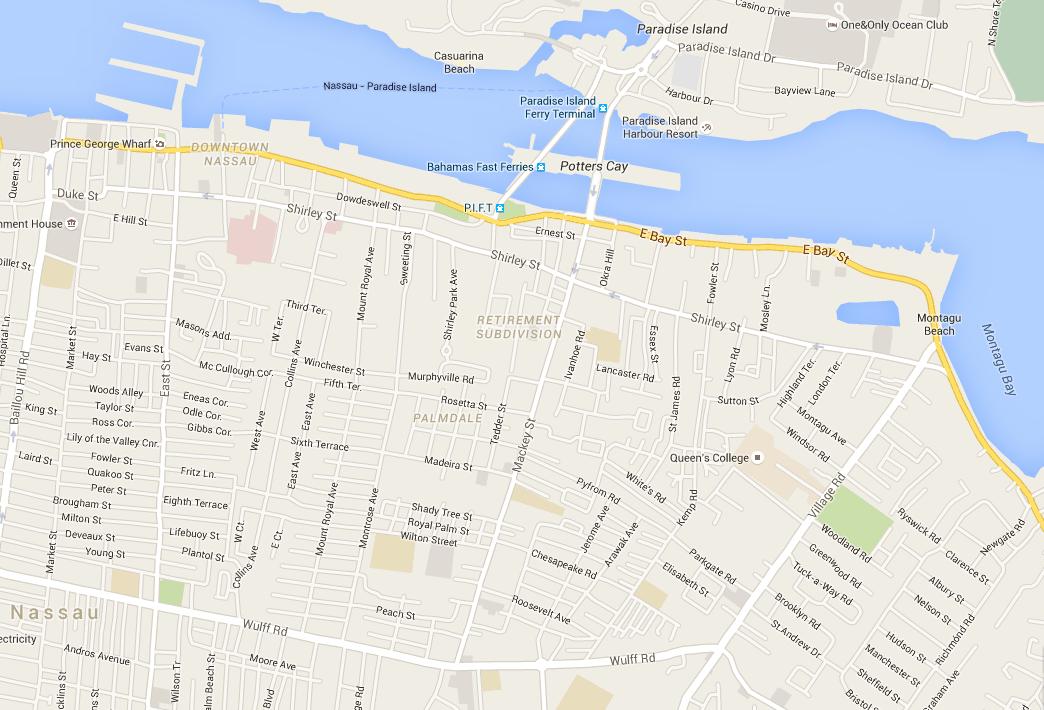
Courtesy of Google Maps
park with a pretty beach on one side: It is difficult to be certain of the route this drive took. If they drove westward from the town center along what is now West Bay Street, they may have come to the area of Goodman's Bay Park. If they drove eastward on East Bay Street, they may have come to Montague Beach.
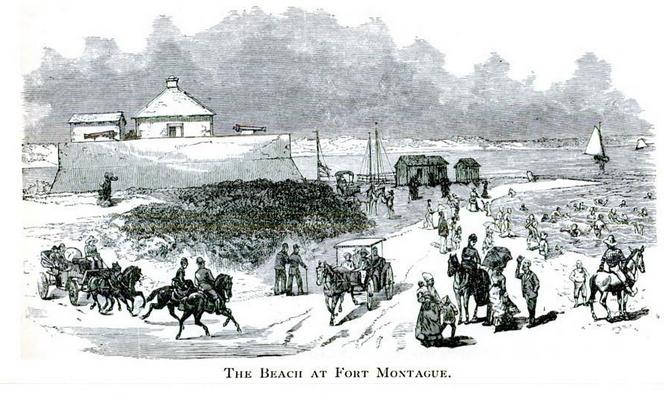
From Stark's History and Guide to the Bahama Islands, p. 121.
jessamine ... hibiscus ... oleander
pointsettia ... trumpet vines: For hibiscus and
oleander, see above January 12 - 16.
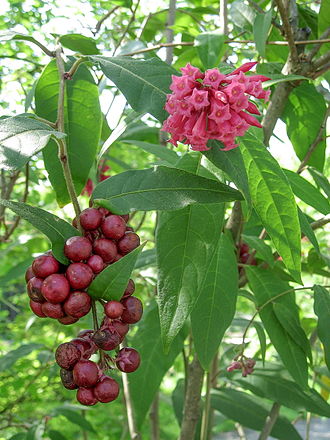 Jessamine / Cestrum from Wikipedia |
 Poinsettia from Wikipedia |
I
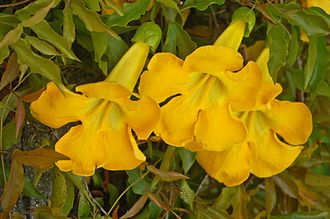 It is likely Fields refers to this native of the Caribbean when she mentions Bahamian trumpet vines. Dolichandra unguis-cati, commonly known as cats claw creeper, funnel creeper,or cat's claw trumpet. Image from Wikipedia. |
[ Sunday January 19 ]
It was a good sermon in the sense of being wise enough but as for any sense of brotherhood being approved in it or any religious fervor -- I could not find it and was glad to get out into the bright air, the sunshine and among the flowers. The Anglican governor's family attended by colored troops gave a sort of magnificence to the occasion.
How lovely the peacock color of the sea looked was as we
rowed back to the ship after the service! In the
afternoon we returned to land and walked about the town,
finding a strange wild cut from the seashore leading toward
steps called the Queen's Staircase which we mounted to find
ourselves on one of the highest points of the island close
by a small castle called Fincastle.* The wind was
blowing strong and cool and as we walked down on the further
side of the hill we found an exquisite invigoration from the
health and beauty of everything about us -- Our dear old
commander* and I continued our walk along the bayside to the
boat. We found jessamine in blossom, and many
delightful and beautiful growths and environing
comfortable houses.
Notes
ashore to the English church: Jewett
wrote
to her sisters about Nassau and the group's activities on
this Sunday. See the 1896 letter for January 19.
This page is written pencil, making it virtually impossible
to read on microfilm. However it is quite readable in
the original manuscript.
the English church: The English
Church in Nassau would have been Christ
Church Cathedral. The church's website notes
that no one is buried in the cathedral, that the
inscriptions are plaques rather than markers. The
Cathedral is located between Prince George Wharf and
Government house, on George St. (See January 18 entry for a
map).
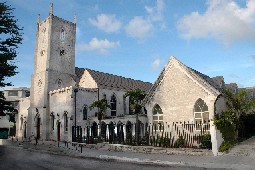
Christ Church Cathedral, Nassau, Bahamas.
From the church's website.
wild cut ... Queen's steps ... Fincastle: The wild cut leading to the Queen's Staircase is near the southwest corner of Shirley and Elisabeth streets, southeast of Prince George Wharf. Wikipedia says that Fort Fincastle was built on Society Hill in 1793: "[T]he fort overlooks the city of Nassau and the Queen’s Staircase, and is often accessed that way by visitors on foot. This fort shaped like a paddle-steamer, Lord Dunmore called Fort Fincastle, after his second title, Viscount Fincastle."
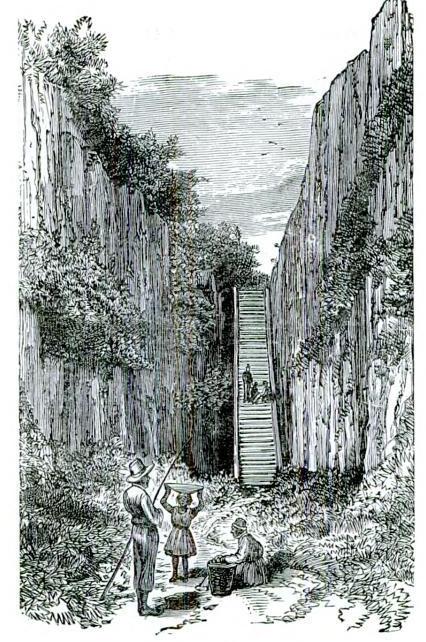 Image of the wild cut and the
Queen's Staircase
from Stark's History and Guide to the Bahama Islands, p. 111. |
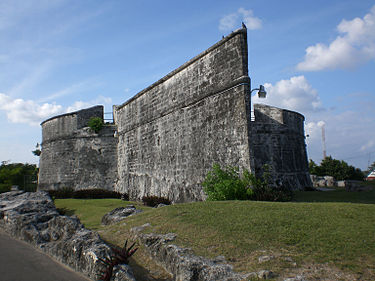 Fort Fincastle, Nassau, Bahamas
Image courtesy of Wikipedia |
commander: Fields usually refers to the crew captain of the Hermione as the captain. Pierce, however, she calls both commodore and commander.
[ Monday January 20 ]
Page 38
Monday Jan 20th We again went ashore for our
last afternoon at Nassau. All went except the poet who
preferred the quiet on board. We drove once more along
the pretty bayside toward the shell shops bringing away
still more "plunder" and then through one of the colored
villages full of life and color and flowers -- and again to
another village where we bought roses and then on and on
through strange wild half desert half marsh lands until we
came near the sea where the palmetto trees* were the most
beautiful I have seen. In the silent loneliness we
stopped to cut the palmettos ^branches^ for the ship
and to look about us -- As far as we could see these
graceful waving creatures, not too close to be seen in their
perfect beauty stood around us, interspersed with the long
swords of the "Sisel," and a fewer more delicate
plants. The yellow blossoming elder* which I have
never seen before which I took at first for a trumpet vine,
begins to show its [chubby ?] heads
everywhere. Our drive was a very long one and we began
to feel a little nervous that the rest
Page 39
of the party should be impatient -- but happily the
glorious sunset as we came out again on the bayside and the
beauty we had seen was enough for them also. It was
not until we reached the boat and I jumped out that she
found her "code book" had slipped out of the carriage {--} a
book to which she had this very day owned her happiness of
interpreting a message from home which said that all was
well. Our commander too had received a message saying
that a long pending law-suit in Ohio which caused them two
months ago to withdraw all their cocoa trade from Ohio had
been settled by the Supreme Court in their favor.* Now
to lose this little book was sad indeed -- but with
insistence we all were requested to return to the ship in
the waiting boat while the little lady began the search all
alone. Happily the people of Nassau are the kindest
and the honestest almost to be found anywhere -- and we had
no fear for her -- An hour later she appeared smiling book
in hand. Her own search had been of little avail
except to have an old one lent to her from the Post Office
-- but she a little ^small^ colored girl
from one of the villages we had passed through presented
Page 40
herself smiling book in hand at the hotel -- delighted to
find the owner. She must have run some miles to bring
it -- happily it was in the cool of the evening.
Notes
yellow blossoming elder: Probably Fields refers to Yellow Elder, native to the Caribbean region. Wikipedia notes: "Yellow trumpetbush is an attractive plant that is cultivated as an ornamental. It has sharply toothed, lance-shaped green leaves and bears large, showy, bright golden yellow trumpet-shaped flowers."
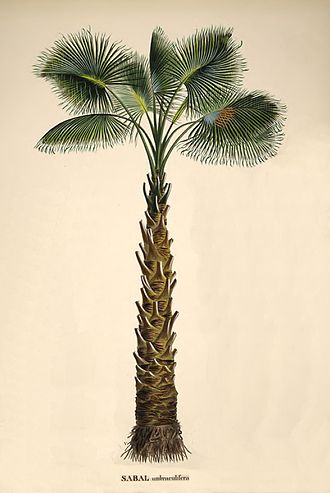 Palmetto Image courtesy of Wikipedia |
 Yellow Elder Image courtesy of Wikipedia |
code book: An example of the many telegraphic code books available for travellers is The Anglo-American Telegraphic Code, published by the Anglo-American Code and Cypher Co.; Third Edition; New York, 1891 (1886). It is something of a mystery who has lost the code book. It seems to be neither Jewett nor Lilian Aldrich, since Fields does not name them, and yet no one else was in their party, except for Bridget, the Aldrich servant.
long pending law-suit in Ohio ... decided by the Supreme Court in their favor: Harry D. Nims, in The Law of Unfair Competition and Trademarks (1917), pp. 125-128, summarizes a series of suits filed by the Baker Chocolate Company regarding trademark infringement, usually dealing with rival manufacturers who made use of the name "Baker" on their products. It seems likely, however, that Fields refers to the case of Rose v. State in Ohio, but that case did not come before a supreme court. In Rose v. State, a retailer was arrested in March 1895 for selling Baker's cocoa mix, because it was an adulterated, impure food under an Ohio statute. The argument was that in preparing chocolate for use in making a beverage, much of the fat content of the natural chocolate had been removed. This made Baker's cocoa mix an impure food that could not be sold in the state of Ohio. The case was heard three times, the first decision supporting the interest of the Baker company, of which Pierce was the owner. However, an appelate court reversed that decision in December 1895, as described in Ohio Nisi Prius and General Term Reports: Decisions of the Courts of Common Pleas and Probate Courts of Ohio; Also of the Superior Court of Cincinnati at General and Special Terms, Volume 2, pp. 270-74. In January 1896, a Circuit Court of Ohio reversed the Appellate Court's ruling: Reports of Cases Argued and Determined in the Circuit Courts of Ohio, Volume 11, pp. 88-100.
Monday night -- We set sail ^got up
steam^ just after midnight leaving pleasant Nassau behind
us. We [steamed ?] all the next day,
Tuesday 21th through a very rough sea all day and all
night and the next day until the afternoon getting into the
road stead of the island of Inagua.* A large island --
the largest ^of the group^ except Andros, but one of the least
fertile. The American Consul Sargent by name put off to
welcome us.* We had been too seasick to wish to [unrecognized
word] but we lay on deck in the soft delicious air and
looked about us.
Notes
island of Inagua ... Andros:
From
Nassau on New Providence to Matthew
Town on Inagua is
about 370 miles. Andros
Island is the largest of the inhabited islands of the
Bahamas, a short distance west of New Providence.
American Consul Sargent: The American consul in the 1890s was Mr. D. (Donald?) D. Sargent. Further information about him and his family is welcome.
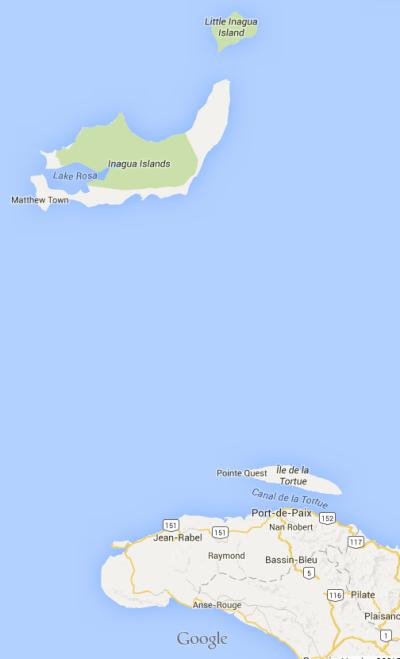
Map of Inagua and northwestern Haiti
Courtesy of Google Maps
[ Thursday 23 January ]
Thursday 23d We started in good season for the shore -- good season for a day at the North -- about 10 o'clock, but the Inn was already very warm. Mr. Sargent was at the beach to welcome us but there is no more landing at Inagua now than there was in the days of Columbus.* All [deleted word] night we could hear the waves dashing up on the cliffs and up the little beach; the breakers still washed rather high although there was no storm. However we ladies were carried ashore by the Captain* except S. O. J. who watched for a chance and deftly jumped and ran.
Page 41
Mr. Sargent met us and led us a short distance to his house, a place built like nearly all houses in this part of the world of lime stone or cement or both with shingle roofs and blinds everywhere, the whole idea being to keep out heat. The floors were scrubbed to a delightful state of cleanliness but everything shows that very little money is to be had anywhere. His wife and her sister received us. The wife had not been away from the island for years! She was born at Nassau and thinks the climate at Inagua even finer than that, nevertheless I could see that the solitude was something terrible. She has had two or three children but as there is no physician at Inagua she has been obliged to go each time to Nassau, a frightful voyage of three or four hundred miles in a sailing vessel! I saw that the time was coming again when she must either go somewhere or have a physician come to her which she cannot afford. Altogether we pitied these two women! [Deleted word] Mr. Pierce kindly asked the whole company to dine with us the same evening, an invitation which was accepted like hungry children; but when the moment arrived the party came without Mrs Sargent! He seemed to us a very self-satisfied sanguine, rather pushing man, though not devoid of good qualities; evidently his energy stands them all in good stead. Her sister, however, poor little thing who came to Inagua after the
Page 42
death of their parents, evidently feels a power
moving within her to support herself and to do
something. Inagua is dull and weighs upon [her ?]
spirit, yet there seems nothing for her to do except to stay
just where she is. However we had a cheerful dinner
together gave them books and papers and sent them on their way
much more cheerful. The same evening we weighed anchor
and left the island of Inagua with its little lonely colony,
its flamingoes its wild wastes the blasting sun and the
shining sea far behinds us.
Notes
the Captain: Information about the captain and crew of the Hermione on this trip would be welcome.
Edited by Terry Heller, Coe College.
The original of this diary is in the collection of the Massachusetts Historical Society. My copy is from a microfilm, available courtesy of the University of Kansas Libraries, Lawrence, Kansas: Annie Adams Fields Papers 1852-1912. Folio PS 1669.F5 Z462 1986, Reel 2.
| Works of Annie Fields |